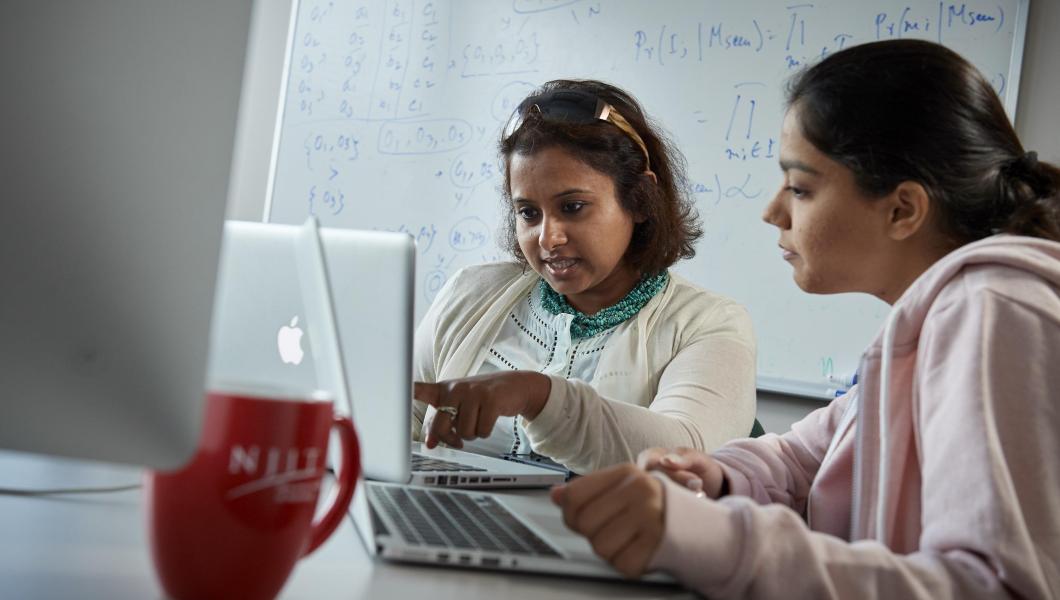NJIT Is Mad for Graduate Studies, With More Than 100 Academic Programs and Counting: Part 2

From traditional classroom learning and accelerated programs to online and hybrid (combining online and face-to-face) instruction, graduate students at NJIT have a variety of options to earn advanced degrees. They also have a lot of choice, with 50+ master’s programs (including 15 fully online), 19 doctoral programs and 40 certificate programs representing an array of STEM disciplines.
In this second of a two-part series, Sotirios G. Ziavras, vice provost for graduate studies, dean of the graduate faculty and professor of electrical and computer engineering, talks about some of NJIT’s newest graduate-study offerings, the recent growth of its graduate student body and the unique professional development support provided to Ph.D. students.
The following interview has been edited for clarity.
What are some recent accomplishments in graduate studies?
Graduate education relies on academic programs that focus on the state of the art. For example, a recent addition is the cell and gene therapy sciences professional science master’s program and a certificate program with the same title offered by the College of Science and Liberal Arts.
In Ying Wu College of Computing (YWCC), the master’s program in data science that was introduced a few years ago attracts large numbers of excellent students who are enrolled at either the Newark campus or YWCC’s Jersey City extension. Two recently introduced certificates on data visualization at YWCC and business analytics at Martin Tuchman School of Management also relate to the big data discipline and their enrollments are expected to grow for many years.
In addition, in September 2019 the Graduate Studies Office started offering the Ph.D. Professional Development Series of seminars to doctoral students as part of NJIT’s efforts to help them improve their professional skills and research productivity, boost their self-esteem, understand diversity issues in the workplace, work effectively as team members, understand how hiring decisions are made for Ph.D. graduates, etc.
Until they graduate, all 500+ Ph.D. students have access to a Ph.D. professional development repository with seminar announcements, online books and documents with information of relevance to their success. A unique process has been set up where Ph.D. students attending the seminars get credit using their cellphones at the event, and I can provide a letter listing the seminars they attended when they are looking for a job.
Finally, a few years ago I initiated the annual three-minute research presentation event for our doctoral students that is now sponsored by the Graduate Student Association. This event focuses on the elevator pitch approach to succinctly “selling the importance of your research,” a process that proves essential during job interviews.
Starting with the 2015-2016 academic year, NJIT’s progress in enrolling doctoral students has been impressive. The number has improved from less than 400 Ph.D. students to well over 500, for an increase of about 37%.
Has the graduate percentage of the student body increased over the past 5-10 years?
Overall, it’s been about the same. However, we should distinguish between doctoral, and master’s and certificate programs. If we look at master’s programs, enrollments of international students across the country are currently at risk and STEM disciplines attract large numbers of international students. However, universities with the “R1” Carnegie Classification® (Highest Research Activity), and NJIT is one of them, still enroll large numbers of international graduate students. Also, NJIT takes new opportunities to enroll students in online and certificate programs, and the recent Jersey City extension is another great example of an initiative taken by the YWCC dean to enroll students who are well placed in competitive industries around the New York City metropolitan area.
I should point out another great development in graduate studies. Starting with the 2015-2016 academic year, NJIT’s progress in enrolling doctoral students has been impressive. The number has improved from less than 400 Ph.D. students to well over 500, for an increase of about 37%. There are several reasons for this improvement. We made remarkable changes to the Ph.D. program requirements and structure to enhance both the quality of programs and also the number of enrolled students. And we moved the timeline for the dissertation proposal defense and the formation of the student’s dissertation committee, which is composed of several faculty members, to start earlier.
Doctoral students now start receiving advice early on from the entire dissertation committee. The more experts they talk to, the more valuable input they can get and the more productive they can become in their research. The new system also rewards academic departments and students as soon as students meet Ph.D. program milestones. Our Ph.D. students are now happier and more productive, so they complete their degrees earlier on average. NJIT will soon be graduating more than 100 doctoral students per year, something that has never happened before.
As you look back at the program’s history and ahead at its future, what is most important for readers to know about the graduate programs?
Graduate education at NJIT has been improving at a very rapid pace. State-of-the-art graduate programs get created on a regular basis and our faculty are a great resource to our students, not only because of their exceptional skills as instructors, but also because they present opportunities for students to get involved in unique research with them.
The intensity and quality of research that takes place at NJIT drives advances in graduate education, and our very capable faculty count immensely on the success of their graduate students. I am sure that our faculty agree with me when I tell new graduate students during the orientation event that, “They will become NJIT’s ambassadors to the world and, as one family, we all gain from each other’s success.”
To read Part 1, click here.

